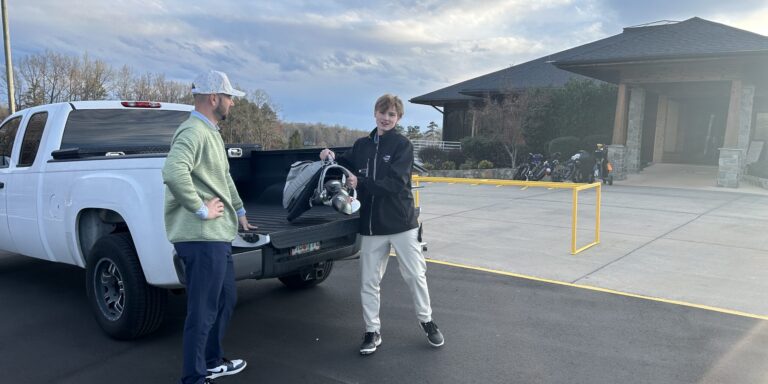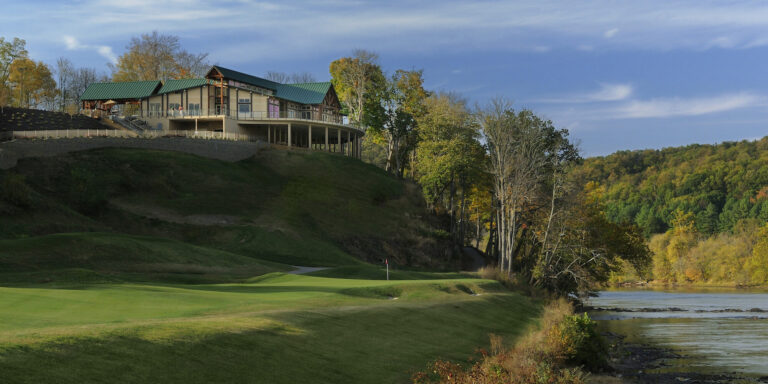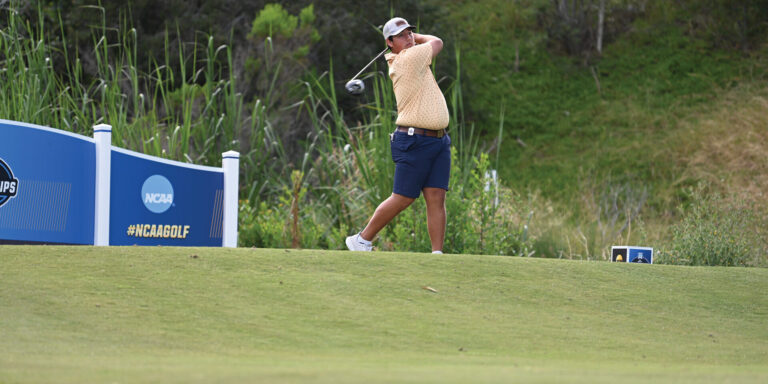The changes at Greensboro National Golf Club are noticeable from the moment players enter the parking lot.
Pulling into the lot, players are directed to pull up to the bag drop, where an attendant will take their clubs out of their vehicle and place it on a cart. When players finish their round, their clubs are cleaned and returned to the bag drop. When they’re ready to leave, players pull up to the drop and their clubs are placed inside their vehicle.
The new rule at the Summerfield course is that players don’t have to touch their clubs when not playing the course or practicing on the range or putting green. And the service is complimentary.
That may be business as usual at public and resort courses in Florida, where Greensboro National general manager Bruce Mohler spent decades in the industry. But it’s not the standard in the Triad. And as Mohler noted, it’s not always the standard at well-known regional resorts such as Pinehurst.
“This are was very far behind,” said Mohler. “I don’t know why — I’m not inventing the wheel here.”
Greensboro National has brought a new level of service to public golf in the Triad through technology as well as good old-fashioned manpower.
The more tech changes are also ground-breaking. A new point-of-sale system allows the course to better know its customers. Not only does the club know names, it knows their equipment and clothes preferences, allowing them to sent push notifications when those brands are on sale in the pro shop or when a favorite club maker is coming for a demo day. Customers can also expect to receive a push notification to remind them of their tee time the next day, as well as an annual birthday greeting.
“It’s set up so a public customer can feel like they’re at a private course,” Mohler said.
The GM said providing the upscale service begins with hiring the proper staff.
“I’m a big believer in having people running an operation that feel that this is their livelihood,” he said. “I want people who want to be here.”
What I want hey these guys are here for us.
With the personal information stored in the EZ-GO Pace technology, the pro shop and beverage cart personal know the location of every cart and the players’ names. So beverage cart servers can call their customers by name when greeting them throughout the course.
When players reach the eighth tee, a QSR code appears on the cart’s GPS message board, allowing players to view the grill menu, order food and pay on their phone. The food is placed for pickup on a table just inside the grill on the way to the 10th tee.
There are no long food breaks that so often cause backups on not only the 10th tee, but throughout the course.
While many of the new tech changes benefit the course, they also make rounds much more enjoyable for most of the players. They eliminate annoying waits on the tees and keep rounds moving smoothly. For example, Mohler said that despite a filled tee sheet with 260 players — the overwhelming majority playing in foursomes — on Labor Day, the average round finished in 4 hours, 16 minutes, a real accomplishment on a busy holiday when players of varying skill levels and experience hit the course.
With the PACE system, Mohler said at least half a dozen staffers at any time can pinpoint every group on the course and ensure pace of play is maintained without logjams.
“It’s gone very well,” Mohler said of customer response. “They like the high service of it.”
But Mohler said the changes weren’t made solely to raise revenues by playing more rounds each day. In fact, Mohler said tee times, which had previously been as little as seven minutes apart, are now separated by either 9 or 10 minutes to give players less waiting time and a more relaxed atmosphere.
As another example of new benefits given to players, Greensboro National supplied free water bottles in their carts’ mini coolers during summer months.
Greensboro National adds upscale services, technology
Virginia Tech’s scenic River Course worthy of drive
As a name, The Pete Dye River Course of Virginia Tech pretty much says it all about the home course of the Hokies golf teams.
The famous – or infamous — Pete Dye was the designer and the course is vintage Dye with a diversity of holes and greens complexes, including pot bunkers, that have made him famous through renowned courses such at TPC Sawgrass, the Ocean Course at Kiawah Island, Harbour Town and of course, The Cardinal by Pete Dye in Greensboro.
The course, which opened in 2006 in Radford, Virginia, about 11 miles from Virginia Tech and a 45-minute drive from Roanoke, is owned by the Virginia Tech Foundation, though managed by McConnell Golf of Raleigh, whose portfolio also includes Sedgefield Country Club, The Cardinal and Old North State Club in the Triad. The foundation bought the course, then home to a more modest layout, and turned it over to Dye, who changed much of bunkering and some of the routing.
Then there’s the New River, which runs along a dozen holes, serving as a lateral hazard while supplying consistent spectacular views of the roaring, wide channel and the magnificent bluffs on the other side. The layout, a links course bordered by a large river rather than an ocean, with sand and natural areas — not trees — lining the fairways and bordering the river.
PGA General Manager Michael Abraham said Dye also eliminated many trees, giving the course a “links” feel and more scenic views of the river.
“I was told that Pete Dye said, ‘I envision this as a links-style course,” Abraham said. “If somebody who played the course before Dye made the changes, they would probably feel like they were on a different course.”
Though located in the foothills of the Blue Ridge Mountains, the River Course sits in the valley, stretching along 2.5 miles on the West Bank of the twisting New River. The clubhouse offers a magnificent view from a perch on the western cliffs.
The course is open to the public. Somewhat remote, the River Course is about 1 hour, 45 minutes from Winston-Salem and 2:15 from Greensboro via U.S. 52 and Interstates 77 and 81.
Dye provided the VT Foundation with a course long and tough enough for top competition but manageable for children and high-handicappers, too. Summer rates are $56 on weekdays and $71 on weekends. Memberships, some with privileges at other McConnell courses, are available.
The course is extremely walkable with no major climbs or long treks between greens and tees.
“It is probably the flattest golf course in the Roanoke-New River Valley area,” Abraham said.
Facilities include practice range and putting green. Preston’s on the River, a full-scale restaurant and bar, is open six days per week, and features a patio looking down over the final hole, the river and the cliffs on the other side.
From the tips, the par-72 course measures 7,685 yards with a 77.3 rating and 145 slope, with other tees playing 7,088, 6,495, 5,903, 5,142, 4,606 and 3,881 yards. Abraham said the commonly played tees are the 6,495-yard Orange, a stiff challenge with a 71.9 rating and a 134 slope.
“We do an annual SWAT analysis and usually the No. 1 threat is how hard our course is,” said Abraham. “We’ve tried to embrace that. We admit we’re tough, but we have different tees.”
Last year, the 4,606-yard yellow set of tees was added, quickly becoming a favorite of many women players.
An example of the course’s versatility and balance, each of the four par-3s play in different directions — north, south, east and west — and important feature considering the typically significant winds off the river. The front and back sides each have one long and one short par-3 hole.
Abraham said the course offers steady winds, sometimes with gusts of 20-25 mph.
The bent grass greens are typically perched with the edges rolling down though extended, tightly mowed collars into a variety of traditional bunkers, pots and grassy swales, requiring skilled chips and pitches. With as much as 10 yards of collar around some greens, players often have the option of putting, though often that requires a firm strike uphill to the speedy, undulating putting surfaces, which typically range in size depending on the expected approach.
The course’s four par-5s are the top handicap holes. Often fairway sand, pots and natural areas encroach on fairways forcing well struck shots to set up an approach.
Players get an early impression of what’s in store upon arrival in the pro shop, which looks down 75 feet from a cliff to No. 18, a long par-4 stretching along the river.
Old Town gives Wake Forest nation’s actual No. 1 ‘college’ course
There’s only one reason Old Town Club, home course of the Wake Forest University golf teams since the campus relocated to Winston-Salem almost seven decades ago, isn’t “officially” regarded as the nation’s top collegiate golf course.
Though the club has several ties to the university, dating back to the ownership of the property, Old Town isn’t a “college course”. It’s a private club with a history intertwined with the university. In fact, until 1968, Wake students and faculty could play the course for $1. Regardless, the several media sources that have ranked college courses in recent years, disqualify Old Town for consideration.
No other college golf team has a comparable course to call home. A classic design by heralded Depression-era architect Perry Maxwell, the layout has enjoyed a spurt of increasing appreciation over the past decade since renovations by the celebrated team of Bill Coore (a Wake alum) and Ben Crenshaw, becoming a consensus top 100 U.S. course in rankings compiled by major magazines.
For example, Golf Magazine ranked Old Town No. 38 among U.S. courses and No. 84 in the world in 2023. Also last year, Golf Digest listed Old Town No. 54 in its U.S. rankings. No “college” course is on those lists.
The 2013 changes included the removal of many trees, creating stunning views of the entire property and making it possible to maintain firm turf conditions, as well as a redesign of bunkers that brought them more into play while giving them a more artistic, natural look, often surrounded by natural vegetation. The greens also were expanded more than 30% to a total of about 110,000 square feet, bringing them close to Maxwell’s original sizes and bringing them closer to the bunkers.
“It has really shot us up all the charts,” Dunlop White, Old Town’s golf chairman, said of the Coore and Crenshaw renovations. “We have catapulted up not only all the lists, but we seem to be on everybody’s radar, too. The changes were very transformative. I can’t believe how far the bar has been raised.”
Old Town remains very much an integral part of Wake golf, a major enticement to many of the nation’s top golf recruits. Almost adjacent to the campus and only a short golf cart ride away for men’s coach Jerry Haas and women’s coach Kim Lewellen, and a few minutes by car for their players, the course has a strong Wake Forest presence — from the many alumni members to the portrait gallery of former Wake greats such as Arnold Palmer in the venerable brick clubhouse.
On the eve of the recent Wyndham Championship, Will Zalatoris, the latest Wake golfers to become a standout on the PGA Tour, returned to Old Town to catch up with former teammates and men’s coach Jerry Haas.
“The whole membership has been awesome to the team,” said Zalatoris, a few days before the start of the Wyndham. “They treated us like members. There was no time we couldn’t play, including Mondays.”
Though Wake has a 17-acre, state-of-the-art indoor/outdoor practice facility on campus, Demon Deacon golfers enjoy that continuous access to the Old Town course, which is not only revered for its classic routing and meticulous grooming, but its rolling topography that forces players to hit shots from all types of uneven lies.
Maxwell’s other heralded designs included Southern Hills and Prairie Dunes. He also made significant improvements to Augusta National following the death of his former design partner Alister MacKenzie. For the design at Old Town, Maxwell had his choice of 165 acres out of the more than 1,000 acres or so offered by Charles and Mary Reynolds Babcock for the new Wake campus and surroundings.
Old Town has a distinctive open look with continuous fairway grass (estimated at 80 acres), connecting several holes and providing scenic vistas over much of the course, which makes good use of Silas Creek on several holes.
The markers in the open tee areas can be adjusted to create significantly differently angles of attack. Red flags mark the front nine pins, yellow identify the back nine pins – important to note because a sprawling, double green serves Nos. 8 and 17.
Though the wide fairways and lack of heavy rough seem inviting off the tees, precision is required to obtain proper angles and ideal lies to attack the pins.
The undulating greens, converted to Tif-Eagle Bermuda last year from bent grass, feature trademark “Maxwell rolls,” small rises sometimes described as “muffins” that require precise putting to properly navigate. Most of the putting surfaces include two or three of these rolls, making them an important factor on approach shots.
“Old Town is very wide open, but the greens are very severe,” said Zalatoris, who stressed the importance of placing tee shots to allow favorable angles for approaches.
Many subtle touches add to enjoyment of the course. No cart paths line the fairways, eliminating bad bounces into trouble areas. Flags on the pins are yellow on the front nine and red on the back, important to note considering the double green. Pin sheets with exact yardage are provided.
Coore and Crenshaw, keeping with their natural, minimalistic phi, acquired Yadkin River brown sand for the bunkers.
“it’s now all about coordinating maintenance with design,” White said, “Most design improvements are in the rearview mirror.”
White said that future plans for the course may include expanding the greens to 115,000 SF, which he said would approximate the original sizes.
From arrival, the experience at Old Town is unique.
The small golf pro shop is behind the impressive brick clubhouse, leaving a short walk through a courtyard flanked by the open teeing areas for Nos. 1 and 10. The casual openness of the courtyard and the flat, non-distinctive teeing areas make for a striking introduction. There are no tee times – just wait your turn in the courtyard and tee off when the fairway is clear.
The routing includes an opening three-hole south loop that leads back near the clubhouse to No. 4, where “The Big Reveal” from the fairway hill provides a view of much of the property. On the back nine, a spectacular, panoramic view back toward the clubhouse can be viewed from the volcano-shaped 16th green.
The most memorable holes include No. 5, a sharp dogleg left par-4 with a largely blind uphill tee shot, and 14, a short par-4 reachable off the tee for the biggest of hitters willing to risk bogey or worse to a fairway and green that slope perilously left toward the creek.
Of course, the par-4 8th and par-5 17th are the signature spots, featuring a double green running along the creek where the pins are typically more than 200 feet apart.
The blind tee shot at 8 travels down a vast fairway sloping toward water on the right with the vast double green a mostly horizontal target. From the right side of the fairway, the red flag is positioned on the left side of the putting surface, leaving players with the unique position of aiming away from the closest pin in their approach over the creek.
At 17, the second shot should be to the lower right side of the fairway, leaving a flatter lie for a short approach over creek to a smaller portion of the green guarded in front by the creek and a small bunker.
Old Town finishes with an uphill, par-4 to a green flanked by the clubhouse.
High Meadows provides beauty, challenge in relaxed atmosphere
As a mountain golf retreat, High Meadows Country Club pretty much has it all, yet its relaxed vibe makes it a relative secret in the N.C. High Country.
Start with the setting in spectacular, yet remote Roaring Gap, a beautiful getaway accessible only via a twisting two-lane road, half and hour from an interstate. Then there’s the club’s George Cobb layout that winds over and through hills and valleys, pristine streams, ponds and lakes, offering a stiff challenge without the likelihood of losing a dozen golf balls in the process.
The mountain-themed clubhouse features fine dining in one formal room overlooking the course and a more casual atmosphere in another separate room, also with a view of the 18th hole, which finishes along a lovely, trout-stocked lake. Perhaps best for a post-round sandwich is a comfy downstairs grill room.
Late this year, the club will open a new indoor-outdoor facility at the practice area, allowing golfers to work on their game regardless the weather conditions. Members will be able hit out from heated bays that can also be closed and used with simulators.
That’s right, High Meadows is one of the few N.C. mountain clubs to keep its golf course open year-round. The club also has the requisite fitness, pickle ball, tennis and swimming facilities. The dining and activity amenities are especially important considering Roaring Gap consists of a historic church, three golf clubs and large overgrown convenience store.
Founded in 1964, at about 3,000-foot elevation, High Meadows blends in nicely with its surrounding community, which includes many residents making it their primary residence.
In recent months, the club is emerging from its leafy shadows with a new vibe creating more activity at the club while maintaining the tranquility cherished by its members.
High Meadows aims to recruit new members to a club that was already surprising affordable with initiation and fees far below comparable upscale exclusive golf clubs in the Triad, Raleigh, Durham, Asheville, Wilmington and Charlotte. For members living 35 miles or more away, the costs are competitive with many semi-private clubs.
In 2024, High Meadows’ new vibe gained notice with the hiring as club professional of longtime Old Town Club staffer Tommy Gibson, the 2021 and 2022 Carolinas PGA Player of the Year.
Robin O’Neil came to the club after several years at Hilton Head Island-area clubs as general manager during the summer. O’Neil is overseeing creation of a new casual dining room and added food and beverage options, driving membership, marketing and facility maintenance and making property enhancements.
O’Neil credits superintendent Jordan Harris, a former assistant at Sedgefield and Primland for maintaining the course’s pristine conditions.
Gibson quickly upgraded the pro shop layout, added new merchandise and equipment and designed a new club logo.
Still, the course remains the showpiece, beginning with the fun, creative design by Cobb, whose portfolio includes Quail Hollow and the par-3 course at Augusta National.
From the back tees, High Meadows is a stiff test of 6,700 yards with several dramatic elevation rises and drops leading to a 72.1 rating and 130 slope. But with five other sets of tees — the front markers measuring just 3,970 yards — the course is playable for scratch players and high-handicappers alike. Only two dozen or so bunkers come into play, but serve strategic purposes.
The greens, a mix of bent and Poa annua that has flourished over the years, range in variety and size, and run true and fast with care taken to avoid impossible to stop downhill putts. The ample fairways, lined by dense trees are divided vertically in color with a “European” style mowing pattern. Several trees were recently trimmed to provide more shot options and sunlight to the fairways.
One of the most unique shots comes at the par-3 11th, which features a dramatic uphill shot to a large green, all but the pin hidden from view on the tee. From the 186-yard tips or 168-yard white tees, the shot can require a long iron then a moment of suspense on the drive to the putting surface.
At 12, a par-5 stretching to 495 yards, players are treated to a spectacular approach to a green with the property’s largest lake serving as the backdrop framed by woods on either side.
No hole may be as fun as the par-4 No. 13, where a good drive carries a plateau and cascades down a steep grade, leaving only a wedge to a small green protected by two bunkers with a pond on the right with U.S. 21 in the distance.
The finishing hole, a 497-yard par-5, features two small lakes, one to the right, coming into play mostly on the second shot; and another to the left, grabbing errant second shots as well as protecting the green on approaches. From the clubhouse deck atop a hill to the right of the green, members can watch players conclude their round in a beautiful setting.
Highlights on the front nine include the 427-yard par-4 sixth, where drives must be accurate to avoid fairway bunkers on both sides with the approach turning slightly left to a small green.
At No. 9, only 333 yards from the tips, big hitters can go for the green off the tee with a required fade, though two small lakes to the left of the green — directly straight from the tee — and dense woods to the right, make double-bogeys common for gamblers.
Hernandez earns medalist honors as UNCG wins at Bryan Park
Kelvin Hernandez took medalist honors as UNC Greensboro won the Bryan National Collegiate tournament Tuesday at Bryan Park Champions course.
Hernandez, a sophomore, shot rounds of 68, 69 and 71 to finish at 8-under-par 208. The Spartans, who also won the event last year, shot 10-under 854 to beat Delaware by two strokes. Boston College was third at 862.
The victory was the first for Hernandez (pictured) in his UNCG career. The Puerto Rico native became the first first UNCG player to qualify for the NCAA Championship last spring.
B.J. Boyce, who shot 66 in the opening round, tied for eighth at 213.
Lincoln Newton adds another summer CGA title
Lincoln Newton of Wallburg continued his winning summer, posting a 6-under-par 134 total Sunday to win the Mimosa Hills Junior Invitational in Morganton by one stroke over James Rhodes of Columbia, South Carolina.
Newton shot 68 in the final round at Mimosa Hills Country Club, including a birdie on No. 16 that proved to be the difference. Rhodes birdied No. 17 to pull within one shot.
In the past six weeks, the 16-year-old Newton, who attends Oak Grove High, also has won the High Point Junior, the CGA Father-Son, the Triad Amateur. Newton birdied the first two holes Sunday during a round of three birdies and only one bogey.
Sanaa Carter of Jacksonville won an eight-hole playoff with MacKenzie Cline of Cary for the Girls’ title after posting 149, including 74 in the final round. The field consisted of 99 boys and 24 girls.
Sam Terry of Thomasville tied for 12th in the Boys’ division at 139. No Triad girls participated.
Barry rallies at Old Town to win Forsyth Amateur
Brett Barry of Winston-Salem shot even-par 70 at Old Town Club on Aug. 18 to win the Forsyth Amateur with a 5-under-par 212 total, two shots ahead of James Glenn.
Barry, a former player at Union University in Jackson, Tennessee, rallied from four shots behind entering the final round. The first two rounds were held at Reynolds Park and Pine Knolls before the field was cut to 16 players.
Wyndham Championship keeps its position on PGA Tour
The Wyndham Championship remains as the PGA Tour’s last regular-season tournament on its 2025 schedule.
The tournament at Sedgefield Country Club will be contested July 31-Aug. 3, according to a release by the PGA Tour. Aaron Rai won the 2024 tournament last week, earning the $1.422 million first prize.
Wyndham will follow the 3M Open in Minnesota. The first playoff tournament begins Aug. 7 in Memphis. Wyndham has a contract as title sponsor of the Greensboro tournament through 2026.
Van Paris, Ford advance to match play at U.S. Amateur
Pinehurst native Jackson Van Paris and University of North Carolina golfer David Ford were among the match play qualifiers Tuesday after 36 holes of stroke play at the U.S. Amateur in Chaska, Minnesota.
Van Paris, a rising senior at Vanderbilt, tied for eighth at 5-under-par 137 after rounds at Chaska Town and Hazeltine National. Peter Fountain of Raleigh, who plays at UNC, finished at 142, advancing to a 14-man playoff for 11 remaining spots.
The final 64 in the 312-player field will begin match play later Wednesday.
Carson Bertagnole, a high school student from Pinehurst, UNC’s Maxwell Ford, UNC Greensboro’s Kelvin Hernandez (pictured) and N.C. State’s Nick Mathews of Mebane failed to make the cut.
Jimmy Ellis, a 39-year-old from Atlantic Beach, Florida, who works in the energy industry, was the medalist at 132, including 61 Tuesday at Chaska Town. No mid-amateur has won the tournament since 1993.
Ellis won the Florida State Amateur in June to earn an exemption into the tourney.
Highs and lows from a rainy Wyndham week at Sedgefield Country Club
Recapping the good and bad from a rainy week at Sedgefield Country Club, where former Duke golfer Max Greyserman made a quadruple-bogey 8 and four-putted for a double-bogey over the final five holes, giving the Wyndham Championship to Aaron Rai.
Rai capped a two-shot victory at 18-under-par 262 with a short birdie putt at No. 18.
THE GOOD
Compelling Finish: The ups and downs of veteran Matt Kuchar, amateur Luke Clanton and Greyserman provided an excellent Sunday show.
Greyserman was the source of the most drama, though. At No. 13, he holed an approach for an eagle to take what appeared to be a commanding four-stroke lead. That command was short-lived because he hit his tee shot out of bounds at 14 on his way to a quadruple-bogey 8 that dropped him into a tie with Aaron Rai.
In Sunday afternoon’s final round, Rai and Ryo Hisatsune were left as Greyserman’s challengers.
First, the popular Kuchar (pictured finishing his third round) emerged from the pack with a second consecutive 64 on a marathon Saturday at Sedgefield Country Club to take the 36-hole lead. Then Clanton eagled both back-nine par-5s on his way to a third-round 62 to pull into a tie for second, only two strokes behind.
Greyserman, who shot 60 in the second round, closed with 66 and 69 — 38 on the back nine.
With a victory, the 46-year-old Kuchar could have extended his streak as the only player to play in each FedEx Cup Playoffs since it began in 2007. Kuchar entered the tournament No. 113 in the FedEx Cup rankings, needing a victory to make the top 70.
So, despite a field missing most of the game’s superstars, the Wyndham again provided a compelling finish, complete with another popular winner with connections to the region.
As far the race to finish in the top 70, typically the top storyline for the Wyndham, not a single player jumped into a playoff spot by virtue of a good finish at Sedgefield.
Sedgefield Country Club: The traditional Donald Ross layout continued to hold up with high rough and treacherous greens providing ample difficulty. On Saturday, we saw Cameron Young hit his approach over the pin to the back tier of the 12rh green then putt off the green and make double-bogey. On Sunday, Aaron Rai, in contention playing with Kuchar and Greyserman, watched his chip from in front of the ninth green hit on the green and roll back off the putting surface.
CBS Coverage: Give credit to CBS for deciding to stick with the final round of the Wyndham through its conclusion on Sunday. The network’s original time slot was 3-6 p.m. And kudos to the deal arranged with the PGA Tour for GolfChannel to take over CBS’ coverage of Saturday’s extended play.
Sedgefield Grounds Crew: With more than 5 inches of rain dumped on the course in fewer than two days, the grounds crew at Sedgefield and PGA Tour staff did marvelous work making the course playable. Though obviously more receptive to approaches, Sedgefield’s undulating Bermuda greens remained fast and tricky. Lift, clean and place and preferred lies made it possible for players to stick approaches from the fairways.
Pro-Am Goes On: Though nobody except the sponsors who pay big money to play with the pros cares, the Wyndham Championship pro-ams were unaffected, played before Hurricane Debby arrived in full force. The pro-am spots, often part of larger sponsorship packages, pay a lot of the bills, so getting in the pro-ams is very important.
THE BAD
Truist Buys Charlotte: Did you notice that Truist sneaked in its announcement about ponying up big bucks (estimated at $200 million) for a seven-year deal to be title sponsor of the former Wells Fargo Championship in Charlotte on Wyndham week, when the dwindling local media was focused on Sedgefield?
BB&T, headquartered for years in Winston-Salem before its merger into Truist, was a presenting sponsor of the Greensboro tournament, and Truist has remained a presenting sponsor of the Wyndham after setting up home with the former SunTrust Bank in Charlotte.
Wyndham has been a generous sponsor and kept the PGA Tour’s longest-running event in Greensboro. The hotel chain’s deal extends through 2026. No extension has been announced.
Wouldn’t it have been nice for BB&T (or Truist) to increased its sponsorship in Greensboro in years past to make this weekend’s tournament one of the PGA Tour’s premier events with the likes of Scottie Scheffler, Xander Schauffele and Rory McIlroy in the field?
No Sir Nick: I miss Nick Faldo as the analyst on CBS. I admit it. I always rooted against him while he was a player. As a proud American, I would never call him “Sir” just because he was a great golfer. As a player, Faldo was a mechanical man who had no interest in the galleries and total contempt for the media.
“I thank you all from the heart of my bottom,” Faldo once told the media at a news conference.
Faldo’s all-par final round to win the 1987 British Open at Muirfield may have been one of the dullest major championship finishes ever. I remember him running through galleries at Augusta National to avoid fans and hiding to smoke cigarettes.
Maybe he was justified in hating the press. I recall the British tabloids (in the media building) mocking him as “Faldope” and “Fooldo” after he hit the wrong ball from high grass at Shinnecock Hills in the 1995 U.S. Open. Maybe he was uncomfortable with the attention.
But Faldo was an outstanding TV analyst, the best in my book — better than Johnny Miller. Faldo, who retired to a ranch in Montana after last year’s Wyndham telecast, was candid, fair and shared some great stories. He provided insight only a player of his caliber could provide. Maybe he can be coaxed out of retirement.
More CBS: Jim Nantz, golf’s premier lead announcer, showed the effects of a long Saturday, referring to the Wyndham as the “John Deere Classic” before quickly correcting himself. No big deal, except Nantz rarely makes such mistakes.
Not sure about everyone else, but my appreciation of pretty, bubbly Amanda Balionis is waning. Ever since she dropped the last name of husband Bryn Renner, was seen out without her wedding ring and posted pics from girls night out in Las Vegas — while rumors surrounded her relationship with Rory McIlroy, who had announced a divorce he has since called off, Balionis’ girl-next-door image is gone. Her gushing interviews are getting stale.
Raining on the Party: Hurricane Debby dampened not only the Sedgefield course, but the hospitality spirit over the weekend. Weekend crowds seemed much smaller than in the past. As players finished late Saturday, the luxury boxes around the final green were largely empty in television shots. To be fair, bad weather, resulting in a crazy schedule, was a major factor.
GOOD AND BAD
Tournament organizers succeeded in finishing the tournament on Sunday, a result good for television, spectators and most of the players. That’s good. Nobody has to come back on Monday. The PGA Tour has its top 70 ready for the upcoming weekend’s tournament.
The bad was not having the leaders battling head-to-head in the final round. The third-round pairings were used for the last 18 holes. The result was third-round leader Greyserman, Kuchar and Rai playing an hour or so behind Clanton, who started the final round on the back nine despite shooting 62 in the third round to move to second place.










